Arduino returns to Linux with Portenta X8 module and dev kit
Mar 24, 2022 — by Eric Brown 2,873 views Arduino will soon launch a $239 “Portenta X8” module that combines a quad -A53 i.MX8M Mini with an STM32 Cortex-M7 and -M4 SoC and runs Linux in a Foundries.io container stack. A $335 “Portenta Max Carrier” will add GbE, USB, COM, CAN, and mini-PCIe.
Arduino will soon launch a $239 “Portenta X8” module that combines a quad -A53 i.MX8M Mini with an STM32 Cortex-M7 and -M4 SoC and runs Linux in a Foundries.io container stack. A $335 “Portenta Max Carrier” will add GbE, USB, COM, CAN, and mini-PCIe.
Arduino Pro, the recently launched professional business unit of Arduino, announced the Portenta X8 module, its first hybrid Linux/Arduino board since the 2018 Arduino Yún Rev 2. (See farther below for a brief history of Linux-ready Arduino boards.)

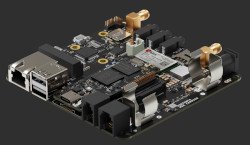
Portenta X8 (left) and plugged into upcoming Portenta Max Carrier
(click images to enlarge)
The industrial grade” Portenta X8, which will expand into an SBC with the help of a Portenta Max Carrier, is preloaded with Linux running within a Docker container using Foundries.io’s cloud-linked Linux microPlatform OS. The stack offers OTA services for up-to-date security and enables the module to run device-independent software.
Stated Arduino Pro: “The X8’s hybrid combination of microprocessor and microcontroller offers developers unprecedented flexibility to complete real-time tasks and high-performance processing simultaneously and securely — running existing Linux apps on a system that puts them immediately in communication with Arduino microcontrollers.”
— ADVERTISEMENT —
Arduino Pro announced the Portenta X8 during 2022 Arduino Week and in mid-April will launch the module for €199 ($239). There will also be a Portenta Max Carrier that will sell for €279 ($335).
The Portenta X8 continues the professional Portenta line of non-Linux Arduino boards such as the $103 Portenta H7.
The 66.04 x 25.4mm module is built around NXP’s i.MX8M Mini system-on-chip with 4x up to 1.8GHz Cortex-A53 cores and an integrated Cortex-M4 at up to 400MHz. The SoC also provides GCNanoUltra (3D) and GC320 (2D) graphics cores. Other sandwich-style i.MX8M Mini products include SolidRun’s HummingBoard Ripple with i.MX8M Mini SOM, among many others.
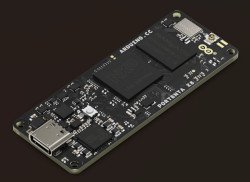

Portenta X8, front and back
(click images to enlarge)
The Portenta X8 also features ST’s STM32H747XI, a dual-core SoC that combines an up to 480MHz Cortex-M7 with the same, up to 240Mhz Cortex-M4 32-bit MCU used on the Portenta H7. The STM32H747XI runs Arduino code and includes an FPU, MPU, and DSP.
In addition to the built-in security features on the i.MX8M Mini, Arduino has added an NXP SE050C2 crypto element to ensure a secure connection at the hardware level, with PSA certification. As a result, the Portenta X8 was awarded Arm SystemReady certification “and integrated Parsec services,” making it one of the first Cassini Products available to developers.
The Portenta X8 ships with 2GB DDR4 and 16GB eMMC. The module integrates a Murata 1DX 802.11n WiFi/Bluetooth module and a Gigabit Ethernet port.
A USB Type-C host and device port provides 5V Power Delivery support. The Type-C port also offers DisplayPort support via a MIPI-DSI/DP bridge, presumably at HD resolution. Separately, 4-lane MIPI-DSI and MIPI-CSI interfaces are listed.
Additional interfaces include 22x DIO, 8x analog input, 4x PWM, 2x SPI, I2S, 3x I2C, 2x USB, 4x UART, CAN, PCIe, SAI, and PDM. The module has a -40 to 85° operating range.
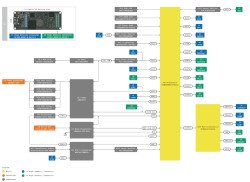

Portenta X8 block diagram (left) and Portenta Breakout add-on
(click images to enlarge)
Arduino had only a few details on the upcoming Portenta Max Carrier, which is pictured at top. The eNUC form factor carrier board includes Ethernet, 2x USB host ports, audio jacks, microSD, mini-PCIe, FD-CAN, RS232/422/485, and dual antenna mounts. The Max Carrier has a 6-36VDC input and a connector for an 18650 Li-ion battery with 3.7V charger.
Portenta X8 options that will be available on launch in a few weeks include the $46 Portenta Breakout for testing and debugging on any Portenta board. The Breakout provides LAN and USB ports, microSD slot, coincell battery, an openMV camera interface, and more.
Additional accessories include the $47.15 Portenta Vision Shield, which offers a 324 x 324 pixel, ultra low-power camera module, dual omnidirectional digital mics, and either Ethernet or LoRa communications. There is also an $87.60 Portenta CAT.M1/NB IoT GNSS Shield with Cat.M1 and NB-IoT radios with optional eSIM plus a choice of GPS, GLONASS, Galileo, or BeiDou.
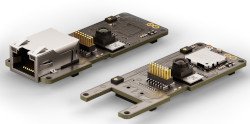

Portenta Vision Shield (left) and Portenta CAT.M1/NB IoT GNSS Shield
(click images to enlarge)
The Portenta X8 was designed for edge computing in industrial contexts, as well as building automation and smart agriculture applications. The module is designed to interact with environmental smart sensors “to implement behavioral analytics that recognize and even prevent collisions, person down incidents, and intrusions,” says Arduino.
“Adding an HMI touchscreen, it becomes a smart dashboard to control any system or application remotely, collecting analytics on consumption at the same time,” says Arduino. “Smart tractors can integrate a Portenta X8-based navigation system that can map crop fields and adjust the trajectory to avoid duplicate fertigation and gather data to improve efficiency in the future.”
Foundries.io Linux microPlatform OS
Cambridge, UK based Foundries.io launched in 2018 as a Linaro spinoff focused on cloud-native development and deployment solutions for secure IoT and edge devices. Last month, the company announced a partnership with Variscite to provide its Linux microPlatform OS and cloud-based DevOps platform for Variscite’s NXP i.MX based modules, starting with the i.MX8M Mini powered VAR-SOM-MX8M-MINI.
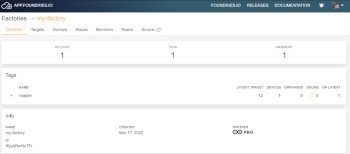
Foundries.io Linux microPlatform OS UI on Portenta X8
(click image to enlarge)
The company’s “fit-for-purpose, customizable” Linux microPlatform OS is based on Yocto Project code and deployed in a Docker container. The solution enables incremental OTA updates and other tools to build, test, deploy and maintain multiple devices. Portenta X8 customers can also gain access to a FoundriesFactory subscription service for fleet management. The Portenta X8 implementation of Linux microPlatform OS supports programming languages like Python, Javascript, Java, Go, and Rust.
Other companies offering similar platforms include Balena (formerly Resin.io), Nubix.io, and Zededa’s Project Eve, which is part of the Linux Foundation’s LF Edge initiative. Canonical’s Ubuntu Core with snaps presents a similar concept.
A brief history of Linux-enabled Arduino boards
By the time Arduino updated its Arduino Yún with the now defunct Arduino Yún Rev 2 in 2018, it was the only Linux-enabled Arduino board on the market. Yet, only a few years earlier, there were several models that ran Linux.
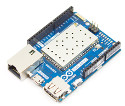 Arduino Yun Rev 2 |
The Arduino Yún Rev 2 made only minor alterations to the original and very successful Yún Rev 1, which arrived in 2013. At that point, Arduino was the most successful open source hardware maker board project in the world. Today, despite the astounding success of the mostly open source Raspberry Pi, the Italy-based Arduino calls itself the world’s leading open-source hardware and software company, with around 30 million active users.
The Arduino project inspired the Raspberry Pi Foundation, which launched its original Raspberry Pi SBC in 2012. Arduino also inspired BeagleBoard.org’s BeagleBoard in 2009 and the BeagleBone Black in 2013.
The Yún boards ran OpenWrt Linux on a MIPS-based, 400MHz AR3991 SoC with built-in 2.4Ghz WiFi from Atheros (now part of Qualcomm). The boards also included a 16MHz Atmel ATmega32U4 chip running Arduino code plus 64MB of DDR2 RAM and 16MB of flash.
The original design inspired the Arduino Yún Mini in 2015. There was also the Arduino Yún Shield add-on to standard Arduino boards and Seeed’s “Seeeduino Cloud pseudo clone, both of which shipped in 2016.
Following the launch of the original Yún, Arduino forked into two projects. The forked Arduino Srl unit pushed out several Linux-based Arduino boards including the Arduino Tian and the Arduino Industrial 101. The 101 incorporated Dog Hunter’s WiFi-enabled Chiwawa module, supported by the OpenWrt-based Linino Linux.
In Oct. 2016, shortly after the launch of the Arduino Industrial 101, Arduino LLC and Arduino Srl settled their legal disputes and reunified as Arduino. Going forward, the Arduino LLC leaders pushed the new product agenda with tiny, non-Linux MKR boards.
Early in the last decade, the OpenWrt-on-Atheros design was the cheapest way to add WiFi to an Arduino board. But then came Espressif’s ESP8266 and more powerful ESP32 MCU SoCs, which combined WiFi/Bluetooth with a dual-core Tensilica Xtensa LX6 that ran Arduino code. With the launch of Arduino’s MKR boards such as the FPGA-enabled MKR Vidor 4000, Linux was out and the ESP32 was in. Until now, the Yún Rev 2 reboot was the only exception.
“A few years ago, with the legendary Yún, Arduino invented a new category of products by combining microcontrollers and microprocessors on a single hardware platform,” stated Fabio Violante, CEO at Arduino. “Today, the world is different: You cannot think about a Linux-based device without anticipating the challenges of securing and maintaining it over time. For this reason, we decided to partner with Foundries.io to simplify this approach by providing a ready-to-use solution that can help our customers build systems with confidence.”
“Foundries.io is in a unique position to advance Arduino’s vision for enabling enterprises to more easily deploy and maintain Linux-based products for IoT and Edge applications,” stated George Grey, CEO at Foundries.io. “The combination of the Portenta X8 and the FoundriesFactory cloud solution will accelerate customer time to market, increase product security and enable rapid deployment and lifetime OTA management of customer devices and fleets, while giving freedom of choice for connectivity to public or private cloud services.”
Further information
The Portenta X8 will go on sale for €199 ($239) in mid-April. You can sign up for availability at this Arduino Shop page. The Portenta Max Carrier will be available later for €279 ($335), presumably including the Portenta X8.
More information may be found on this Foundries.io announcement and blog post, as well as Arduino Pro’s Portenta H8 landing page and product page.

Translated: Good for Arduino, but very expensive, Raspberry is still a cheap option for industrial developments.